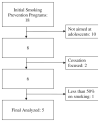What works to prevent adolescent smoking? A systematic review of the National Cancer Institute's Research-Tested Intervention Programs
- PMID: 19691713
- PMCID: PMC3004538
- DOI: 10.1111/j.1746-1561.2009.00426.x
What works to prevent adolescent smoking? A systematic review of the National Cancer Institute's Research-Tested Intervention Programs
Abstract
Background: Cigarette use remains the leading preventable cause of death in the United States. Although school is an ideal setting for antismoking interventions, school-based programs have not been successful in the long term. The purpose of this study was to explore characteristics of programs deemed to be successful short-term Research-Tested Intervention Programs (RTIPs) by the National Cancer Institute (NCI).
Methods: To identify adolescent smoking prevention programs, 2 independently working researchers applied specified selection criteria to all programs in the NCI's RTIP database. Selected programs were abstracted using a structured form for general information, participants, interventions, outcomes, and quality. Extracted data were then assessed for common themes and contrasts in each category.
Results: As of June 2008, 18 studies met the NCI's standards for RTIPs preventing smoking among adolescents. After selection criteria were applied, only 5 programs remained. Each independently working researcher arrived at the same pool of programs. In chronological order according to date of publication of outcomes evaluation, the 5 programs ultimately included were Project Towards No Tobacco Use, Pathways to Health, Native FACETS, Kentucky Adolescent Tobacco Prevention Project, and Sembrando Salud. The majority of these programs were targeted toward a particular sociodemographic group (eg, American Indians, Hispanic migrant communities).
Conclusions: New school-based programs are needed to address current issues in tobacco control. To improve chances of success, these programs may wish to target certain specific high-risk demographic groups, use professional health educators and/or trained community members, and build in methods of updating material.
Figures
References
-
- Mokdad AH, Marks JS, Stroup DF, Gerberding JL. Actual causes of death in the United States, 2000. JAMA. 2004;291(10):1238–1245. - PubMed
-
- Eaton DK, Kann L, Kinchen S, et al. Youth risk behavior surveillance-United States, 2005. MMWR Surveill Summ. 2006;55(5):1–108. - PubMed
-
- Escobedo LG, Marcus SE, Holtzman D, Giovino GA. Sports participation, age at smoking initiation, and the risk of smoking among US high school students. JAMA. 1993;269(11):1391–1395. - PubMed
Publication types
MeSH terms
Grants and funding
LinkOut - more resources
Full Text Sources
Medical
Research Materials
Miscellaneous


